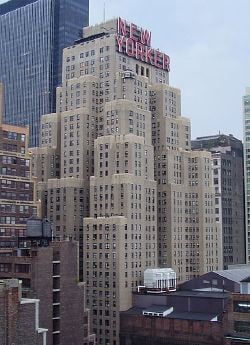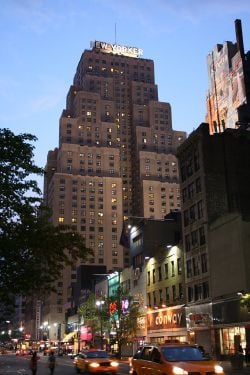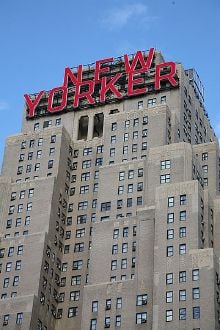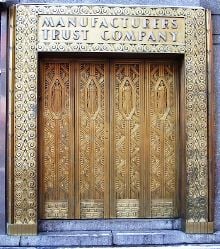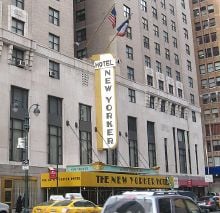Difference between revisions of "New Yorker Hotel" - New World Encyclopedia
m |
(imported updated Wikipedia article) |
||
| Line 1: | Line 1: | ||
| − | {{ | + | {{Infobox building |
| + | |hotel_name = The Wyndham New Yorker Hotel | ||
| + | |image = NewYorker Hotel.JPG | ||
| + | |image_width = 250 | ||
| + | |caption = The hotel, with its large "New Yorker" sign | ||
| + | |location = 481 Eighth Avenue, New York, NY 10001<br>United States | ||
| + | |coordinates = {{coord|40|45|10|N|73|59|38|W|}} | ||
| + | |opening_date = 1930 | ||
| + | |stars = | ||
| + | |diamonds = | ||
| + | |closing_date = | ||
| + | |developer = | ||
| + | |architect = [[Henry M. Sugarman|Sugarman and Berger]] | ||
| + | |operator = [[Wyndham Hotels & Resorts]] | ||
| + | |owner = [[Unification Church of the United States]] | ||
| + | |number_of_restaurants = 2 (originally 5) | ||
| + | |number_of_rooms = 1,083 (originally 2,500) | ||
| + | |number_of_suites = 64 | ||
| + | |floor_area = {{convert|1,000,000|sqft|m2|abbr=on}} | ||
| + | |floors = 43 (21 for hotel) | ||
| + | |parking = | ||
| + | |website = [http://www.newyorkerhotel.com www.newyorkerhotel.com] | ||
| + | |footnotes = | ||
| + | }} | ||
| + | [[File:New Yorker Hotel.JPG|thumb|right|250px|At night]] | ||
| − | + | The '''Wyndham New Yorker Hotel''' is a historic hotel located at 481 [[Eighth Avenue (Manhattan)|Eighth Avenue]] in [[New York City]], [[United States]]. The 43-story [[Art Deco]] hotel, opened 1930, is a 1,083-room, mid-priced hotel located in [[Manhattan]]'s [[Garment District, Manhattan|Garment District]] and [[Hell's Kitchen, Manhattan|Hell's Kitchen]] areas, near [[Pennsylvania Station (New York City)|Pennsylvania Station]], [[Madison Square Garden]], [[Times Square]], and the [[Empire State Building]]. The {{convert|1|e6sqft|m2|sing=on|abbr=off}} building offers two restaurants and approximately {{convert|33,000|sqft|m2}} of conference space.<ref name=NYObserver>{{cite web|url=http://www.observer.com/2011/06/caught-between-the-moonies-and-new-york-city-the-new-yorker-hotels-office-idea/|title=Caught Between the Moonies and New York City: The New Yorker Hotel’s Office Idea|date=24 June 2011|publisher=|accessdate=30 October 2016}}</ref> Since re-opening as a hotel in 1994, it has undergone approximately $100 million in capital improvements, including lobby and room renovations and infrastructure modernization. The [[Unification Church]] purchased the building in 1975, and since 2014, it has been part of the [[Wyndham Hotels & Resorts]] chain. | |
| − | + | Due to its noticeable marquee and proximity to the [[Empire State Building]], it makes appearances in many films and is the backdrop for TV-studio reports and interviews broadcast worldwide from New York by [[BBC News]]. | |
| − | + | ==Early history== | |
| − | The New Yorker Hotel | + | ===Construction=== |
| + | The New Yorker Hotel was built by Garment Center developer Mack Kanner. When the project was announced in 1928, the [[Henry M. Sugarman|Sugarman and Berger]] designed building was planned to be 38 stories, at an estimated cost of $8 million.<ref>{{cite book |last=Sexton |first=R.W. |title=American Apartment Houses, Hotels, and Apartment Hotels of Today |publisher=Architectural Book Publishing Company, Inc. |year=1929 |location=New York, New York |pages=184–185}}</ref><ref>{{cite web|url=http://query.nytimes.com/gst/abstract.html?res=9806E5D6113DE73ABC4B53DFB5668383639EDE&legacy=true|title=Plans for the New Yorker, 38-Story 8th Av. Hotel, Filed|date=3 March 1928|publisher=|accessdate=30 October 2016|via=NYTimes.com}}</ref> However, when it was completed in 1929, the building had grown to 43 stories, at a final cost of $22.5 million and contained 2,500 rooms, making it the city's largest for many years.<ref>{{cite web|url=https://select.nytimes.com/gst/abstract.html?res=F50713FE3C5B12718DDDA80894D1405B898EF1D3&scp=4&sq=%22new%20yorker%20hotel%22&st=p|title=GREATER ACTIVITY FOR 34TH STREET; Westerly Blocks Destined to Be an Important Office Building Centre. AMPLE TRANSIT FACILITIES Mack Kanner, Builder of Hotel New Yorker, Predicts Commercial Growth.|date=1 September 1929|publisher=|accessdate=30 October 2016|via=NYTimes.com}}</ref><ref name="HotelNewYorkerHistory">https://www.newyorkerhotel.com/history/</ref> Hotel management pioneer [[Ralph Hitz]] was selected as its first manager, eventually becoming president of the National Hotel Management Company. An early ad for the building boasted that the hotel's "bell boys were 'as snappy-looking as [[West Point]]ers'" and "that it had a radio in every room with a choice of four stations".<ref name=OneThousand>'One Thousand New York Buildings'', by Jorg Brockman and Bill Harris, page 257, Published by Black Dog & Leventhal Publishers, Inc., 2002</ref> It was a New Yorker bellboy, [[Johnny Roventini]], who served as tobacco company [[Philip Morris USA|Philip Morris']] pitchman for twenty years, making famous their "Call for Philip Morris" advertising campaign.<ref>{{cite web|url=https://www.nytimes.com/2004/05/01/business/joseph-f-cullman-3rd-who-made-philip-morris-a-tobacco-power-dies-at-92.html|title=Joseph F. Cullman 3rd, Who Made Philip Morris a Tobacco Power, Dies at 92|date=1 May 2004|work=The New York Times|accessdate=30 October 2016}}</ref> | ||
| − | The New Yorker Hotel | + | The hotel opened on January 2, 1930.<ref name="nyo 201411">{{cite web |url=http://observer.com/2014/11/long-famous-but-not-quite-fabulous-the-new-yorker-hotel/ |title=Long Famous But Not Quite Fabulous: The New Yorker Hotel |work=New York Observer |date=20 November 2014 |accessdate=3 December 2014 |author=Velsey, Kim}}</ref> Much like its contemporaries, the [[Empire State Building]] (1931) and the [[Chrysler Building]] (1930), the New Yorker was designed in the [[Art Deco]] style which was popular in the 1920s and 1930s. In his book ''New York 1930'' [[Robert A. M. Stern]] said the "New Yorker's virtually unornamented facades consisted of alternating vertical bands of warm gray brick and windows, yielding an impression of boldly modeled masses. This was furthered by the deep-cut light courts, which produced a powerful play of light and shade that was enhanced by dramatic lighting at night".<ref>''New York 1930, Architectural and Urbanism Between the Two World Wars'', by Robert A.M. Stern, Gregory Gilmartin, Thomas Mellins, page 204, Published by Rizzoli International Publications, Inc., 1987</ref> In addition to the ballrooms there were ten private dining "salons" and five restaurants employing 35 master cooks.<ref name=HotelNewYorkerHistory /> The barber shop was one of the largest in the world with 42 chairs and 20 manicurists.<ref name=HotelNewYorkerHistory /> There were 95 switchboard operators and 150 laundry staff washing as many as 350,000 pieces daily.<ref name=HotelNewYorkerHistory /><ref name=OneThousand /> |
| − | == | + | ===Later years=== |
| − | + | [[File:Aug09 TeslaPlaque.jpg|thumb|left|220px|Plaque honoring [[Nikola Tesla]], who lived in the hotel for ten years until he died]] | |
| + | [[File:New Yorker building.jpg|thumb|left|220px|Close-up of the tower]] | ||
| + | Throughout the 1940s and 1950s, the hotel was among New York's most fashionable. The ''New York Observer'' noted that in the building's heyday, "actors, celebrities, athletes, politicians, mobsters, the shady and the luminous—the entire Brooklyn Dodgers roster during the glory seasons—would stalk the bars and ballrooms, or romp upstairs";<ref name=NYObserver /> It hosted many popular [[Big Band]]s, such as [[Benny Goodman]] and [[Tommy Dorsey]],<ref name=HotelToBecomeHospital>{{cite web|url=https://www.nytimes.com/1972/04/20/archives/new-yorker-hotel-sold-to-become-a-hospital-closes-doors-after-42.html|title=New Yorker Hotel, Sold to Become a Hospital, Closes Doors After 42 Years|first=Werner|last=Bamberger|date=20 April 1972|publisher=|accessdate=30 October 2016|via=NYTimes.com}}</ref> while notable figures such as [[Spencer Tracy]], [[Joan Crawford]] and [[Fidel Castro]] stayed there. Inventor [[Nikola Tesla]] spent the last ten years of his life in near-seclusion in Suite 3327, where he died, largely devoting his time to feeding pigeons while occasionally meeting dignitaries.<ref name="nyo 201411"/><ref>[http://www.newsday.com/features/booksmags/ny-e5677204may11,0,2101752.story?track=rss Cooing for a strange genius] [[Bloomberg News]], 2008-05-11</ref> In later years, [[Muhammad Ali]] would recuperate there after his March 1971 fight against [[Joe Frazier]] at the Garden.<ref name=NYObserver /><ref name="nyo 201411" /> | ||
| + | |||
| + | Notwithstanding its early success, New York's changing economy and demographics caused the building to slowly decline and, as a result, its ownership changed several times. It was purchased by [[Hilton Hotels]] in 1953 for $12.5 million and following an [[antitrust]] suit by the federal government, was sold just three years later, in 1956, for $20 million to Massaglia Hotels.<ref>{{cite web|url=https://www.nytimes.com/1953/11/26/archives/hilton-chain-acquiring-new-yorker-hotel-here.html|title=Hilton Chain Acquiring New Yorker Hotel Here|first=Special To The New York|last=Times|date=26 November 1953|publisher=|accessdate=30 October 2016|via=NYTimes.com}}</ref><ref>{{cite web|url=https://www.nytimes.com/1956/05/15/archives/new-yorker-hotel-is-sold-by-hilton-group-to-massaglia-owner-of.html|title=New Yorker Hotel Is Sold by Hilton Group To Massaglia, Owner of chain of 11 Units|first=Special To The New York|last=Times|date=15 May 1956|publisher=|accessdate=30 October 2016|via=NYTimes.com}}</ref> In 1959, Massaglia sold the hotel to an investment syndicate known as New York Towers Ltd., which went bankrupt, allowing Hilton to reacquire the building in 1967.<ref>{{cite web|url=http://query.nytimes.com/gst/abstract.html?res=9D03E3D8113AEF33A2575AC0A9649D946691D6CF&legacy=true|title=New Yorker Hotel Repurchased by Hilton Chain; Purchase Subject to Debts|first=Joseph P.|last=Fried|date=9 December 1967|publisher=|accessdate=30 October 2016|via=NYTimes.com}}</ref> | ||
| + | |||
| + | By the time Hilton reacquired the hotel, the pronounced decline in New York's fortunes, coupled with the construction of new, more modern hotels, caused the New Yorker to become unprofitable. As a result, Hilton closed the hotel in April 1972.<ref name=HotelToBecomeHospital /> | ||
| + | |||
| + | Initially left vacant, several proposals were made for the building, including redevelopment as a low-income housing development, and a hospital.<ref name=HotelToBecomeHospital /> Ultimately, in 1975, it was purchased by the [[Unification Church of the United States]] for $5.6 million. The church converted much of the building for use by its members.<ref>Biermans, J. 1986, ''The Odyssey of New Religious Movements, Persecution, Struggle, Legitimation: A Case Study of the Unification Church Lewiston'', New York and Queenston, Ontario: The Edwin Melton Press {{ISBN|0-88946-710-2}}</ref> | ||
| + | |||
| + | ===Power plant=== | ||
| + | When it was built, the New Yorker Hotel had coal-fired steam boilers and generators sufficient to produce more than 2,200 [[Watt (unit)|kilowatts]] of [[direct current]] electric power. At the time, this was the largest private power plant in the United States. The hotel's own direct current generators were still in use during the [[Northeast Blackout of 1965]], but by the late 1960s the hotel's power system had been modernized to [[alternating current]].<ref name="nyo 201411"/><ref>Tom Blalock, '' Powering the New Yorker: A Hotel's Unique Direct Current System'', in ''IEEE Power and Energy Magazine'', Jan/Feb 2006</ref> In a dedication ceremony held on September 25, 2008, The Institute of Electrical and Electronics Engineers (IEEE) named the New Yorker Hotel's direct current power plant a [[List of IEEE milestones|Milestone in Electrical Engineering]]. A bronze plaque commemorating the achievement was presented to the hotel by IEEE. | ||
| + | |||
| + | ==Reopening== | ||
| + | [[File:Bank door 34th Street.jpg|thumb|220px|right|Former Manufacturers Hanover Bank branch entrance]] | ||
| + | [[File:New Yorker Hotel jeh.JPG|thumb|left|220px|8th Avenue entrance]] | ||
| + | |||
| + | In 1994, the Unification Church elected to convert a portion of the building to use as a hotel again and the New Yorker Hotel Management Company took over operation of the building. It began the largest renovation project in the New Yorker's nearly 65-year history, completed in 1999, with $20 million in capital improvements.<ref>{{cite web|url=https://www.nytimes.com/1999/01/06/nyregion/commercial-real-estate-making-new-yorker-hotel-new-again.html|title=Commercial Real Estate; Making New Yorker Hotel New Again|date=6 January 1999|work=The New York Times|accessdate=30 October 2016}}</ref> The hotel joined the Ramada chain in 2000. | ||
| + | |||
| + | In August 2007, the hotel began a second capital improvement program, which was completed in February 2009 at a final cost of $70 million. These improvements increased the number of guest rooms available from 178 in 1994 to 912, located on floors 19 through 40.<ref name=PressRelease>[http://www.newyorkerhotel.com/Press/Renovations_Announcement.pdf "New Yorker Hotel embarks on $65 million renovation"]. Press release.</ref><ref name=RenovationCompletion>{{cite web|url=http://www.hotel-online.com/News/PR2009_1st/Feb09_NewYorker.html|title=The 912 room New Yorker Hotel Completes Massive 18-month, $70 million Renovation / February 2009|first=Richard L.|last=Johnson|publisher=|accessdate=30 October 2016}}</ref> | ||
| + | |||
| + | The renovation project was designed by Stonehill & Taylor Architects.<ref name=RenovationCompletion /> Interior improvements included room restructuring and augmentation (now called "Metro" and "City View" rooms). Other improvements included a refurbished front entrance, lobby redesign, foyer reconstruction, and ballroom renovations. The hotel also expanded its [[Wi-Fi]] and [[PDA]] support, and added high-definition flat-screen televisions in all rooms. In addition, individual room air-conditioning units were replaced with modern centralized heating and cooling systems throughout the entire hotel. In 2009, conference room space was added to the hotel through the conversion of a defunct [[Manufacturers Hanover Corporation|Manufacturer's Hanover Bank]] branch in the hotel, bringing the total meeting space to just over {{convert|33000|sqft|m2}}, in two ballrooms and twelve conference rooms. | ||
| + | |||
| + | The New Yorker Hotel joined the Wyndham Hotels chain in March 2014.<ref>{{cite web|author=Hotel News Resource |url=http://www.hotelnewsresource.com/article76676.html |title=Iconic New Yorker Hotel Joins Wyndham Brand |publisher=Hotelnewsresource.com |date=2014-03-03 |accessdate=2016-03-05}}</ref> Wyndham has undertaken additional upgrades to the hotel, including lobby and restaurant renovations, to attract more business travelers in anticipation of the massive [[Hudson Yards Redevelopment Project]] to the west.<ref name="nyo 201411" /> | ||
| + | {{clear}} | ||
| − | + | ==References== | |
| − | + | {{reflist|2}} | |
| − | |||
| − | [[ | + | ==External links== |
| + | {{Commons category}} | ||
| + | * {{Official website|http://www.newyorkerhotel.com}} | ||
| + | * [http://www.wyndham.com/hotels/new-york/new-york/wyndham-new-yorker-hotel/hotel-overview Official Chain website] | ||
| + | * [http://www.in-arch.net/NYC/nyc2a.html#129/ New York Skyscrapers-Art Deco Page] | ||
| + | * [http://www.teslasociety.com/nyhotel.htm Tesla Society.com] | ||
| + | * [http://blog.modernmechanix.com/2008/05/15/modern-hotel-is-a-huge-machine/ Modern Mechanix: New Yorker Hotel] | ||
| + | {{Hotels in New York City}} | ||
| − | {{ | + | {{coord|40|45|10|N|73|59|38|W|type:landmark_region:US-NY|display=title}} |
| − | {{ | + | {{Credits|Wyndham_New_Yorker_Hotel|792984109}} |
| − | |||
Revision as of 18:43, 2 August 2017
The Wyndham New Yorker Hotel is a historic hotel located at 481 Eighth Avenue in New York City, United States. The 43-story Art Deco hotel, opened 1930, is a 1,083-room, mid-priced hotel located in Manhattan's Garment District and Hell's Kitchen areas, near Pennsylvania Station, Madison Square Garden, Times Square, and the Empire State Building. The Template:Convert/e6sqft building offers two restaurants and approximately 33,000 square feet (Expression error: Unrecognized punctuation character ",". m²) of conference space.[1] Since re-opening as a hotel in 1994, it has undergone approximately $100 million in capital improvements, including lobby and room renovations and infrastructure modernization. The Unification Church purchased the building in 1975, and since 2014, it has been part of the Wyndham Hotels & Resorts chain.
Due to its noticeable marquee and proximity to the Empire State Building, it makes appearances in many films and is the backdrop for TV-studio reports and interviews broadcast worldwide from New York by BBC News.
Early history
Construction
The New Yorker Hotel was built by Garment Center developer Mack Kanner. When the project was announced in 1928, the Sugarman and Berger designed building was planned to be 38 stories, at an estimated cost of $8 million.[2][3] However, when it was completed in 1929, the building had grown to 43 stories, at a final cost of $22.5 million and contained 2,500 rooms, making it the city's largest for many years.[4][5] Hotel management pioneer Ralph Hitz was selected as its first manager, eventually becoming president of the National Hotel Management Company. An early ad for the building boasted that the hotel's "bell boys were 'as snappy-looking as West Pointers'" and "that it had a radio in every room with a choice of four stations".[6] It was a New Yorker bellboy, Johnny Roventini, who served as tobacco company Philip Morris' pitchman for twenty years, making famous their "Call for Philip Morris" advertising campaign.[7]
The hotel opened on January 2, 1930.[8] Much like its contemporaries, the Empire State Building (1931) and the Chrysler Building (1930), the New Yorker was designed in the Art Deco style which was popular in the 1920s and 1930s. In his book New York 1930 Robert A. M. Stern said the "New Yorker's virtually unornamented facades consisted of alternating vertical bands of warm gray brick and windows, yielding an impression of boldly modeled masses. This was furthered by the deep-cut light courts, which produced a powerful play of light and shade that was enhanced by dramatic lighting at night".[9] In addition to the ballrooms there were ten private dining "salons" and five restaurants employing 35 master cooks.[5] The barber shop was one of the largest in the world with 42 chairs and 20 manicurists.[5] There were 95 switchboard operators and 150 laundry staff washing as many as 350,000 pieces daily.[5][6]
Later years
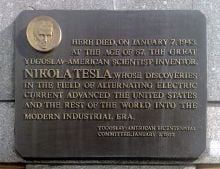
Throughout the 1940s and 1950s, the hotel was among New York's most fashionable. The New York Observer noted that in the building's heyday, "actors, celebrities, athletes, politicians, mobsters, the shady and the luminous—the entire Brooklyn Dodgers roster during the glory seasons—would stalk the bars and ballrooms, or romp upstairs";[1] It hosted many popular Big Bands, such as Benny Goodman and Tommy Dorsey,[10] while notable figures such as Spencer Tracy, Joan Crawford and Fidel Castro stayed there. Inventor Nikola Tesla spent the last ten years of his life in near-seclusion in Suite 3327, where he died, largely devoting his time to feeding pigeons while occasionally meeting dignitaries.[8][11] In later years, Muhammad Ali would recuperate there after his March 1971 fight against Joe Frazier at the Garden.[1][8]
Notwithstanding its early success, New York's changing economy and demographics caused the building to slowly decline and, as a result, its ownership changed several times. It was purchased by Hilton Hotels in 1953 for $12.5 million and following an antitrust suit by the federal government, was sold just three years later, in 1956, for $20 million to Massaglia Hotels.[12][13] In 1959, Massaglia sold the hotel to an investment syndicate known as New York Towers Ltd., which went bankrupt, allowing Hilton to reacquire the building in 1967.[14]
By the time Hilton reacquired the hotel, the pronounced decline in New York's fortunes, coupled with the construction of new, more modern hotels, caused the New Yorker to become unprofitable. As a result, Hilton closed the hotel in April 1972.[10]
Initially left vacant, several proposals were made for the building, including redevelopment as a low-income housing development, and a hospital.[10] Ultimately, in 1975, it was purchased by the Unification Church of the United States for $5.6 million. The church converted much of the building for use by its members.[15]
Power plant
When it was built, the New Yorker Hotel had coal-fired steam boilers and generators sufficient to produce more than 2,200 kilowatts of direct current electric power. At the time, this was the largest private power plant in the United States. The hotel's own direct current generators were still in use during the Northeast Blackout of 1965, but by the late 1960s the hotel's power system had been modernized to alternating current.[8][16] In a dedication ceremony held on September 25, 2008, The Institute of Electrical and Electronics Engineers (IEEE) named the New Yorker Hotel's direct current power plant a Milestone in Electrical Engineering. A bronze plaque commemorating the achievement was presented to the hotel by IEEE.
Reopening
In 1994, the Unification Church elected to convert a portion of the building to use as a hotel again and the New Yorker Hotel Management Company took over operation of the building. It began the largest renovation project in the New Yorker's nearly 65-year history, completed in 1999, with $20 million in capital improvements.[17] The hotel joined the Ramada chain in 2000.
In August 2007, the hotel began a second capital improvement program, which was completed in February 2009 at a final cost of $70 million. These improvements increased the number of guest rooms available from 178 in 1994 to 912, located on floors 19 through 40.[18][19]
The renovation project was designed by Stonehill & Taylor Architects.[19] Interior improvements included room restructuring and augmentation (now called "Metro" and "City View" rooms). Other improvements included a refurbished front entrance, lobby redesign, foyer reconstruction, and ballroom renovations. The hotel also expanded its Wi-Fi and PDA support, and added high-definition flat-screen televisions in all rooms. In addition, individual room air-conditioning units were replaced with modern centralized heating and cooling systems throughout the entire hotel. In 2009, conference room space was added to the hotel through the conversion of a defunct Manufacturer's Hanover Bank branch in the hotel, bringing the total meeting space to just over 33,000 square feet (3,100 m²), in two ballrooms and twelve conference rooms.
The New Yorker Hotel joined the Wyndham Hotels chain in March 2014.[20] Wyndham has undertaken additional upgrades to the hotel, including lobby and restaurant renovations, to attract more business travelers in anticipation of the massive Hudson Yards Redevelopment Project to the west.[8]
ReferencesISBN links support NWE through referral fees
- ↑ 1.0 1.1 1.2 Caught Between the Moonies and New York City: The New Yorker Hotel’s Office Idea (24 June 2011). Retrieved 30 October 2016.
- ↑ Sexton, R.W. (1929). American Apartment Houses, Hotels, and Apartment Hotels of Today. New York, New York: Architectural Book Publishing Company, Inc., 184–185.
- ↑ Plans for the New Yorker, 38-Story 8th Av. Hotel, Filed (3 March 1928). Retrieved 30 October 2016.
- ↑ GREATER ACTIVITY FOR 34TH STREET; Westerly Blocks Destined to Be an Important Office Building Centre. AMPLE TRANSIT FACILITIES Mack Kanner, Builder of Hotel New Yorker, Predicts Commercial Growth. (1 September 1929). Retrieved 30 October 2016.
- ↑ 5.0 5.1 5.2 5.3 https://www.newyorkerhotel.com/history/
- ↑ 6.0 6.1 'One Thousand New York Buildings, by Jorg Brockman and Bill Harris, page 257, Published by Black Dog & Leventhal Publishers, Inc., 2002
- ↑ Joseph F. Cullman 3rd, Who Made Philip Morris a Tobacco Power, Dies at 92. The New York Times (1 May 2004). Retrieved 30 October 2016.
- ↑ 8.0 8.1 8.2 8.3 8.4 Velsey, Kim (20 November 2014). Long Famous But Not Quite Fabulous: The New Yorker Hotel. New York Observer. Retrieved 3 December 2014.
- ↑ New York 1930, Architectural and Urbanism Between the Two World Wars, by Robert A.M. Stern, Gregory Gilmartin, Thomas Mellins, page 204, Published by Rizzoli International Publications, Inc., 1987
- ↑ 10.0 10.1 10.2 Bamberger, Werner (20 April 1972). New Yorker Hotel, Sold to Become a Hospital, Closes Doors After 42 Years. Retrieved 30 October 2016.
- ↑ Cooing for a strange genius Bloomberg News, 2008-05-11
- ↑ Times, Special To The New York (26 November 1953). Hilton Chain Acquiring New Yorker Hotel Here. Retrieved 30 October 2016.
- ↑ Times, Special To The New York (15 May 1956). New Yorker Hotel Is Sold by Hilton Group To Massaglia, Owner of chain of 11 Units. Retrieved 30 October 2016.
- ↑ Fried, Joseph P. (9 December 1967). New Yorker Hotel Repurchased by Hilton Chain; Purchase Subject to Debts. Retrieved 30 October 2016.
- ↑ Biermans, J. 1986, The Odyssey of New Religious Movements, Persecution, Struggle, Legitimation: A Case Study of the Unification Church Lewiston, New York and Queenston, Ontario: The Edwin Melton Press Template:ISBN
- ↑ Tom Blalock, Powering the New Yorker: A Hotel's Unique Direct Current System, in IEEE Power and Energy Magazine, Jan/Feb 2006
- ↑ Commercial Real Estate; Making New Yorker Hotel New Again. The New York Times (6 January 1999). Retrieved 30 October 2016.
- ↑ "New Yorker Hotel embarks on $65 million renovation". Press release.
- ↑ 19.0 19.1 Johnson, Richard L.. The 912 room New Yorker Hotel Completes Massive 18-month, $70 million Renovation / February 2009. Retrieved 30 October 2016.
- ↑ Hotel News Resource (2014-03-03). Iconic New Yorker Hotel Joins Wyndham Brand. Hotelnewsresource.com. Retrieved 2016-03-05.
External links
- {{#invoke:Official website|main}}{{#invoke:Check for unknown parameters|check|showblankpositional=1|unknown=|preview=Page using Template:Official website with unknown parameter "_VALUE_"|1|2|URL|url|mobile|name|format}}
- Official Chain website
- New York Skyscrapers-Art Deco Page
- Tesla Society.com
- Modern Mechanix: New Yorker Hotel
Template:Hotels in New York City
Coordinates:
Credits
New World Encyclopedia writers and editors rewrote and completed the Wikipedia article in accordance with New World Encyclopedia standards. This article abides by terms of the Creative Commons CC-by-sa 3.0 License (CC-by-sa), which may be used and disseminated with proper attribution. Credit is due under the terms of this license that can reference both the New World Encyclopedia contributors and the selfless volunteer contributors of the Wikimedia Foundation. To cite this article click here for a list of acceptable citing formats.The history of earlier contributions by wikipedians is accessible to researchers here:
The history of this article since it was imported to New World Encyclopedia:
Note: Some restrictions may apply to use of individual images which are separately licensed.
